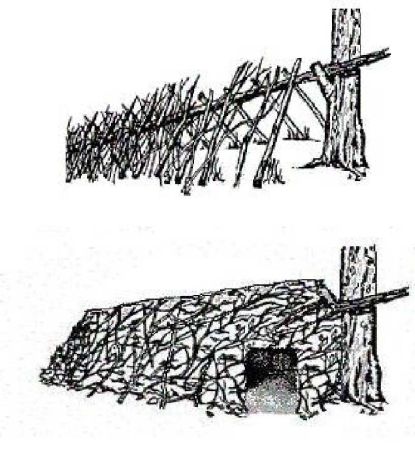Wilderness Survival 101: Debris shelters
Once you’ve chosen the ideal location for your shelter it’s time to begin the building process. The easiest and most durable kind of shelter, assuming you’re in a wooded area, is a debris shelter. While debris shelters can take many forms – lean-to, hut, tipi – the gist is simple: your shelter will be built entirely from natural materials using various sized branches and twigs as a frame and a ton of leaves, moss, bark (read: debris) as insulation.
The easiest of the debris shelters is the hut. A debris hut consists of three “sides”and an open area from which to enter and exit your shelter. You’ll also want to maintain your fire near this opening. Here’s how it’s done:
1. Find a tree at your location with a low branch or find a stump that’s roughly 3 feet off the ground. In either case you’ll need the tree/stump to support a long, thicker stick which will serve as the primary support for your lean-to.
2. Next, find a lengthy, thick, sturdy branch. It can be fallen or you can harvest one from the surrounding trees but regardless insure the branch is fairly straight and at least as tall you are. If you’re using tree to support your shelter (see step 1) you’ll also want to double check the branch is sufficiently long to fit into the elbow of the tree AND still cover enough ground for you to lie down. If you’re using a stump this is not as big a problem.
3. Lean the branch you found in step 2 into the elbow of the tree or log you’ve chosen as your shelter’s base. Next it’s time to find the “ribs” of your shelter. You’ll need to find numerous sticks and smaller branches to lean against the the thick branch you found in step 2. Pretty standard: one end in the ground, one against the support beam. Space the ribs roughly an inch apart, covering one side of the support beam. Then do the same covering roughly half the length of the other side leaving a opening near the tree trunk or stump you’re using as a support. This will be your entry point.
4. The next thing you’ll need is “lattice” – find a bunch of twiggy, springy branches to lay on top of the ribs. These will help prevent any “debris” from falling into the cavity of your hut. You’ll need sufficient lattice to completely cover your hut structure.
5. Now it’s finally time to gather the debris. Look for whatever is readily available. Since it’s likely you’ll be here for while feel free to harvest living debris as well as gathering what’s available on the forest floor. You’ll want to look for fallen leaves, moss, bark, ferns, and similar. Gather as much debris as possible – you’ll need to cover your entire shelter (except the entrance) with it. Continue heaping on debris until you’re up to your elbow in debris when you reach through the leaves on top of your shelter to touch the ribs.
6. Line the inside of the shelter with fresh leaves and debris. This will make the ground softer and help you keep insulated.
You can easily make a debris hut suitably sized for 1-3 people to fit fairly comfortably. If there are more than 3 people in your party however you’ll either want to consider building multiple huts, a modified version of the hut (similar to the long houses of Pacific Northwest Native Americans), or a debris tipi.
Honestly, this process is going to take you an entire day. It just isn’t easy for one or two people to gather all these materials by themselves. But it’s necessary.
Once your shelter is ready it’s time to move on to building a fire – but that’s for the next post. 🙂
-Wren
